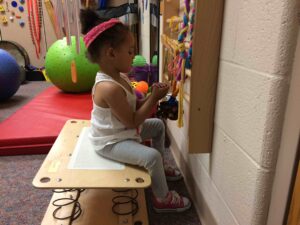Sitting Independently

Independent sitting requires strong neck, shoulder, and core muscles. It also requires balance and good proprioception (feedback from joints and muscles to your brain). Vision can also play a role in developing sitting skills. A key goal for sitting is to be able to use your arms, hands, legs, feet and head while in that position. This requires a lot of practice using and coordinating movements in various sitting postures.
In the earliest stages of development nondisabled children take anywhere from 4 to 9 months learning to sit independently. For children with significant disabilities this can be a much longer process. They need regular and systematic support to achieve this very important skill. Active Learning, because of its intensive focus on movement, can help work on this important skill outside of specific therapy time, increasing the practice time so necessary for the student.
Your physical therapist is an invaluable support in developing a plan to work on sitting. Discuss strategies and activities that will meet your individual child’s needs. Here are just a few ideas to show that working on sitting can be done in a variety of environments and activities:
-
- Spend time working in prone on a Support Bench to increase core and shoulder muscle strength and improve head control.
- While positioned on his/her back, have the learner reach up for objects overhead using a Little Room, Mobile, or Echo Bucket.
- From lying or supported sitting, reach up and clasp an adult’s hands to play hand games.
-
- sitting on an ESSEF board and playing with items on an Activity Wall,
- shifting weight to maintain an upright position in a HOPSA dress,
- sitting in front of or in the lap of an adult and rocking side-to-side and forward-backward, or
- lying on his back and coming to sitting with support (check with your PT about specific strategies).
Sitting in an Adapted Chair
Children benefit from activities that they do in a seated position. Using an adapted chair is one way to provide a child with this experience. The child can improve muscles in the torso and neck while completing activities.
Sitting on an ESSEF Board
Part of learning to sit upright is being able to shift your balance in a seated position. Using an Essef Board is one way to practice this skill as the child has to work to maintain balance on the board as he moves his legs and arms. Photo courtesy of the Narbethong State School in Queensland, Australia.
Sitting with Legs Extended
Learning to sit with legs extended allows the child to play on the floor and begin to practice moving to other positions. Photo courtesy of the Narbethong State School in Queensland, Australia.
Sitting with the Back Against an Essef Board
Sitting with the back against an Essef Board provides additional sensation to the child’s back. It also allows the child to press her back into a surface and experiment with balance. Photo courtesy of the Narbethong State School in Queensland, Australia.
Sitting on a Therapy Ball
While the child is sitting on a therapy ball and bouncing, hang objects in front so the child can reach out to engage with them.Video demonstration of the therapy ball activity
PLAY FULL VIDEO
Sitting on a Resonance Board
Position the child sitting on a Resonance Board with a variety of items that can be manipulated by taking out, putting in, taking apart, and so forth. This also allows the child to visually or tactually search for various items to play with, an important skill for orientation and mobility.Video demonstration of play while sitting on a Resonance Board
PLAY FULL VIDEO
Sitting in a Chair
Place the child sitting in a chair with roller skates on his or her feet with massaging board and cookie sheet underneath. As the child moves their legs (in a seated position), they can listen to and compare the sounds. They also can experience simply rolling their feet on the ground. The added weight of roller skates also helps to strengthen the legs. If you don’t have skates, consider using shoes with taps or adding things to the bottom of the child’s shoes, such as metal washers or coins, or tape soda cans to the bottom of their shoes. These can create great sounds! Another variation is to use a chair with on wheels, such as an office chair, and let the child wear skates as you help push him or her along. The child can feel the vibration of the wheels on the floor or surface and the movement of the chair. Of course it is always important to stay close to the child during this type of activity, when the chair is not secured.Video example of play with skates while sitting in a chair
PLAY FULL VIDEO
Kayden Sitting on Drums
Description: In this video we see a 5-year-old girl seated on a stack of two gathering drums. After playing with the drums, she is introduced to a Meinl Helix Bowl, which she explores.PLAY FULL VIDEO 0:02:33
Downloads:
